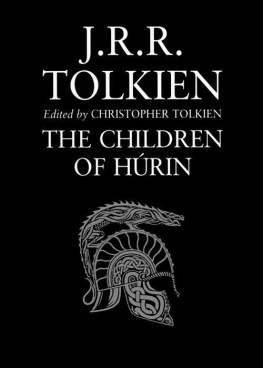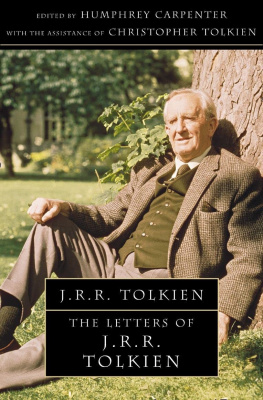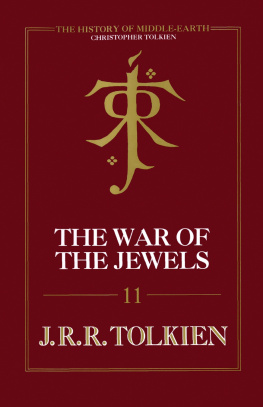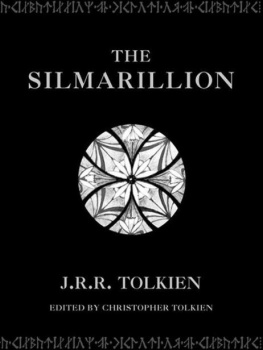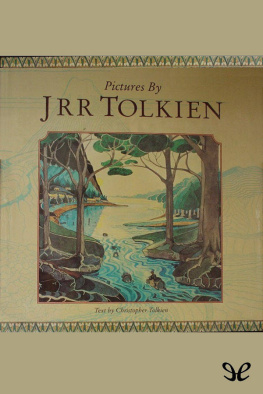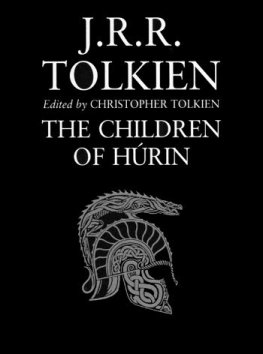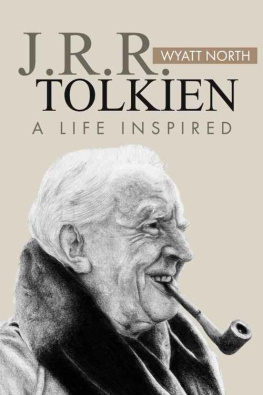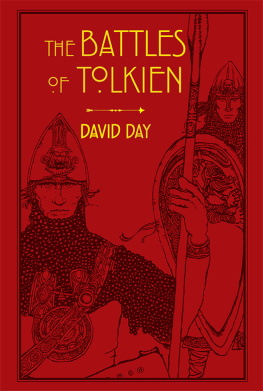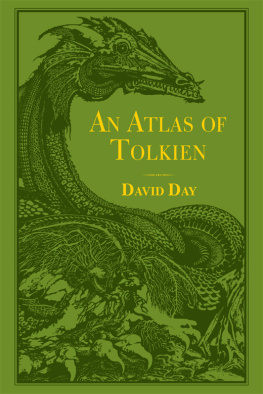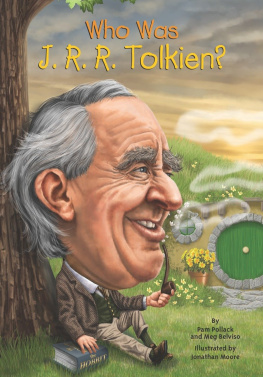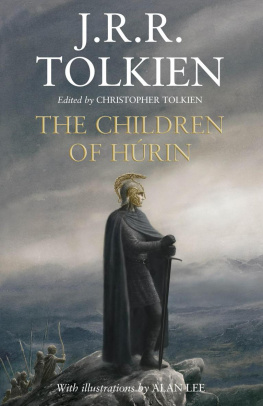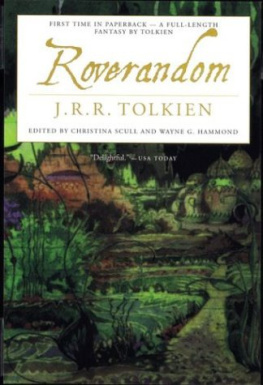J. R. R. Tolkien - The Children of Húrin
Here you can read online J. R. R. Tolkien - The Children of Húrin full text of the book (entire story) in english for free. Download pdf and epub, get meaning, cover and reviews about this ebook. year: 2009, publisher: HarperCollins Publishers, genre: Art. Description of the work, (preface) as well as reviews are available. Best literature library LitArk.com created for fans of good reading and offers a wide selection of genres:
Romance novel
Science fiction
Adventure
Detective
Science
History
Home and family
Prose
Art
Politics
Computer
Non-fiction
Religion
Business
Children
Humor
Choose a favorite category and find really read worthwhile books. Enjoy immersion in the world of imagination, feel the emotions of the characters or learn something new for yourself, make an fascinating discovery.
- Book:The Children of Húrin
- Author:
- Publisher:HarperCollins Publishers
- Genre:
- Year:2009
- Rating:4 / 5
- Favourites:Add to favourites
- Your mark:
- 80
- 1
- 2
- 3
- 4
- 5
The Children of Húrin: summary, description and annotation
We offer to read an annotation, description, summary or preface (depends on what the author of the book "The Children of Húrin" wrote himself). If you haven't found the necessary information about the book — write in the comments, we will try to find it.
The Children of Húrin — read online for free the complete book (whole text) full work
Below is the text of the book, divided by pages. System saving the place of the last page read, allows you to conveniently read the book "The Children of Húrin" online for free, without having to search again every time where you left off. Put a bookmark, and you can go to the page where you finished reading at any time.
Font size:
Interval:
Bookmark:


NARN I CHN HRIN
The Tale of the Children of Hrin
BY
J.R.R. TOLKIEN
Edited by Christopher Tolkien

To
BAILLIE TOLKIEN
Contents
It is undeniable that there are a very great many readers of The Lord of the Rings for whom the legends of the Elder Days (as previously published in varying forms in The Silmarillion , Unfinished Tales , and The History of Middle-earth ) are altogether unknown, unless by their repute as strange and inaccessible in mode and manner. For this reason it has seemed to me for a long time that there was a good case for presenting my fathers long version of the legend of the Children of Hrin as an independent work, between its own covers, with a minimum of editorial presence, and above all in continuous narrative without gaps or interruptions, if this could be done without distortion or invention, despite the unfinished state in which he left some parts of it.
I have thought that if the story of the fate of Trin and Ninor, the children of Hrin and Morwen, could be presented in this way, a window might be opened onto a scene and a story set in an unknown Middle-earth that are vivid and immediate, yet conceived as handed down from remote ages: the drowned lands in the west beyond the Blue Mountains where Treebeard walked in his youth, and the life of Trin Turambar, in Dor-lmin, Doriath, Nargothrond, and the Forest of Brethil.
This book is thus primarily addressed to such readers as may perhaps recall that the hide of Shelob was so horrendously hard that it could not be pierced by any strength of men, not though Elf or Dwarf should forge the steel or the the children of hrin hand of Beren or of Trin wield it, or that Elrond named Trin to Frodo at Rivendell as one of the mighty Elf-friends of old; but know no more of him.
When my father was a young man, during the years of the First World War and long before there was any inkling of the tales that were to form the narrative of The Hobbit or The Lord of the Rings , he began the writing of a collection of stories that he called The Book of Lost Tales. That was his first work of imaginative literature, and a substantial one, for though it was left unfinished there are fourteen completed tales. It was in The Book of Lost Tales that there first appeared in narrative the Gods, or Valar; Elves and Men as the Children of Ilvatar (the Creator); Melkor-Morgoth the great Enemy; Balrogs and Orcs; and the lands in which the Tales are set, Valinor land of the Gods beyond the western ocean, and the Great Lands (afterwards called Middle-earth, between the seas of east and west).
Among the Lost Tales three were of much greater length and fullness, and all three are concerned with Men as well as Elves: they are The Tale of Tinviel (which appears in brief form in The Lord of the Rings as the story of Beren and Lthien that Aragorn told to the hobbits on Weathertop; this my father wrote in 1917), Turambar and the Foalk (Trin Turambar and the Dragon, certainly in existence by 1919, if not before), and The Fall of Gondolin (191617). In an often-quoted passage of a long letter describing his work that my father wrote in 1951, three years before the publication of TheFellowship of the Ring , he told of his early ambition: once upon a time (my crest has long since fallen) I had a mind to make a body of more or less connected legend, ranging from the large and cosmogonic, to the level of romantic fairy-story the larger founded on the lesser in contact with the earth, the lesser drawing splendour from the vast backcloths... I would draw some of the great tales in fullness, and leave many only placed in the scheme, and sketched.
It is seen from this reminiscence that from far back it was a part of his conception of what came to be called The Silmarillion that some of the Tales should be told in much fuller form; and indeed in that same letter of 1951 he referred expressly to the three stories which I have mentioned above as being much the longest in The Book of Lost Tales. Here he called the tale of Beren and Lthien the chief of the stories of The Silmarillion , and of it he said: the story is (I think a beautiful and powerful) heroic-fairy-romance , receivable in itself with only a very general vague knowledge of the background . But it is also a fundamental link in the cycle, deprived of its full significance out of its place therein. There are other stories almost equally full in treatment, he went on, and equally independent, and yet linked to the general history: these are The Children of Hrin and The Fall of Gondolin.
It thus seems unquestionable, from my fathers own words, that if he could achieve final and finished narratives on the scale he desired, he saw the three Great Tales of the Elder Days (Beren and Lthien, the Children of Hrin, and the Fall of Gondolin) as works sufficiently complete in themselves as not to demand knowledge of the great body of legend known as The Silmarillion . On the other hand, as my father observed in the same place, the tale of the Children of Hrin is integral to the history of Elves and Men in the Elder Days, and there are necessarily a good many references to events and circumstances in that larger story.
It would be altogether contrary to the conception of this book to burden its reading with an abundance of notes giving information about persons and events that are in any case seldom of real importance to the immediate narrative. However, it may be found helpful here and there if some such assistance is provided, and I have accordingly given in the Introduction a very brief sketch of Beleriand and its peoples near the end of the Elder Days, when Trin and Ninor were born; and, as well as a map of Beleriand and the lands to the North, I have included a list of all names occurring in the text with very concise indications concerning each, and simplified genealogies.
At the end of the book is an Appendix in two parts: the first concerned with my fathers attempts to achieve a final form for the three tales, and the second with the composition of the text in this book, which differs in many respects from that in Unfinished Tales .
I am very grateful to my son Adam Tolkien for his indispensable help in the arrangement and presentation of the material in the Introduction and Appendix, and for easing the book into the (to me) daunting world of electronic transmission.
Middle-earth in the Elder Days
The character of Trin was of deep significance to my father, and in dialogue of directness and immediacy he achieved a poignant portrait of his boyhood, essential to the whole: his severity and lack of gaiety, his sense of justice and his compassion; of Hrin also, quick, gay, and sanguine, and of Morwen his mother, reserved, courageous, and proud; and of the life of the household in the cold country of Dor-lmin during the years, already full of fear, after Morgoth broke the Siege of Angband, before Trin was born.
But all this was in the Elder Days, the First Age of the world, in a time unimaginably remote. The depth in time to which this story reaches back was memorably conveyed in a passage in The Lord of the Rings. At the great council in Rivendell Elrond spoke of the Last Alliance of Elves and Men and the defeat of Sauron at the end of the Second Age, more than three thousand years before:
Thereupon Elrond paused a while and sighed. I remember well the splendour of their banners, he said. It recalled to me the glory of the Elder Days and the hosts of Beleriand, so many great princes and captains were assembled. And yet not so many, nor so fair, as when Thangorodrim was broken, and the Elves deemed that evil was ended for ever, and it was not so.You remember? said Frodo, speaking his thought aloud in his astonishment. But I thought, he stammered as Elrond turned towards him, I thought that the fall of Gil-galad was a long age ago.So it was indeed, answered Elrond gravely. But my memory reaches back even to the Elder Days. Erendil was my sire, who was born in Gondolin before its fall; and my mother was Elwing, daughter of Dior, son of Lthien of Doriath. I have seen three ages in the West of the world, and many defeats, and many fruitless victories.Next pageFont size:
Interval:
Bookmark:
Similar books «The Children of Húrin»
Look at similar books to The Children of Húrin. We have selected literature similar in name and meaning in the hope of providing readers with more options to find new, interesting, not yet read works.
Discussion, reviews of the book The Children of Húrin and just readers' own opinions. Leave your comments, write what you think about the work, its meaning or the main characters. Specify what exactly you liked and what you didn't like, and why you think so.

